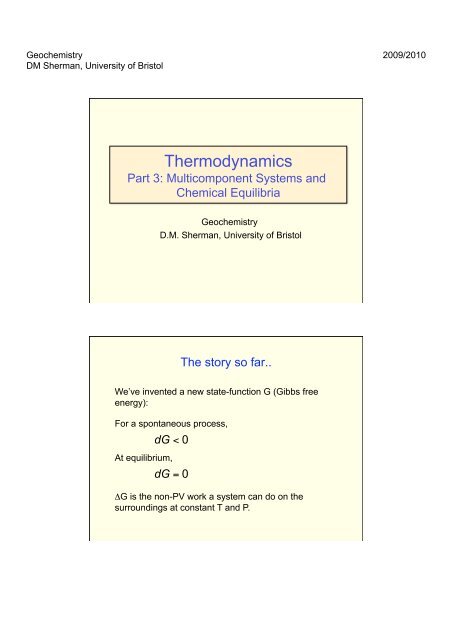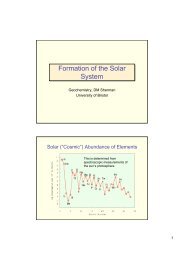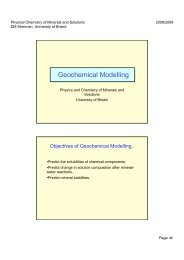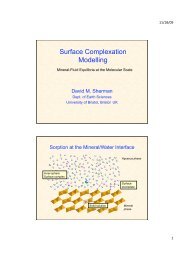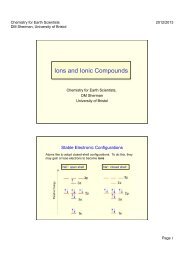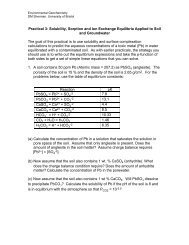Thermodynamics - Aqueous and Environmental Geochemistry
Thermodynamics - Aqueous and Environmental Geochemistry
Thermodynamics - Aqueous and Environmental Geochemistry
You also want an ePaper? Increase the reach of your titles
YUMPU automatically turns print PDFs into web optimized ePapers that Google loves.
<strong>Geochemistry</strong><br />
DM Sherman, University of Bristol<br />
2009/2010<br />
<strong>Thermodynamics</strong><br />
Part 3: Multicomponent Systems <strong>and</strong><br />
Chemical Equilibria<br />
<strong>Geochemistry</strong><br />
D.M. Sherman, University of Bristol<br />
The story so far..<br />
€<br />
€<br />
We’ve invented a new state-function G (Gibbs free<br />
energy):<br />
For a spontaneous process,<br />
dG < 0<br />
At equilibrium,<br />
dG = 0<br />
ΔG is the non-PV work a system can do on the<br />
surroundings at constant T <strong>and</strong> P.
<strong>Geochemistry</strong><br />
DM Sherman, University of Bristol<br />
2009/2010<br />
Free Energy of a Gas<br />
Let’s determine G of a gas as a function of pressure<br />
At constant T,<br />
dG = −SdT +VdP<br />
€<br />
€<br />
dG = VdP<br />
which we can integrate to get<br />
G(P) − G(P 0 ) =<br />
P<br />
∫VdP<br />
P 0<br />
€<br />
For an ideal gas,<br />
Free Energy of a Gas (cont.)<br />
PV = nRT or V = nRT<br />
P<br />
So the integral becomes<br />
€<br />
G(P) − G(P 0 ) =<br />
P<br />
∫ VdP = nRT ∫<br />
1 P dP<br />
P 0<br />
P<br />
P 0<br />
€<br />
⎛<br />
G(P) = G(P 0 ) + nRT ln P ⎞<br />
⎜ ⎟<br />
⎝ P 0 ⎠<br />
€
<strong>Geochemistry</strong><br />
DM Sherman, University of Bristol<br />
2009/2010<br />
Free Energy of Mixtures<br />
Define the chemical potential of component i as<br />
€<br />
⎛<br />
µ i = ∂G ⎞<br />
⎜ ⎟<br />
⎝ ∂n i ⎠<br />
T,P,n j≠i<br />
Using the chemical potential, we can define the free<br />
energy of a mixture:<br />
G = G(P,T,n 1 ,…,n i )<br />
(n i is the number of moles of i)<br />
dG = VdP − SdT + ∑<br />
i<br />
µ i<br />
dn i<br />
€<br />
Free Energy of Mixtures (cont.)<br />
In a gas which consists of a mixture, we can define the<br />
partial pressure p i of each component. For an ideal gas,<br />
we have<br />
p i V = n i RT<br />
∑<br />
i<br />
p i<br />
= P tot<br />
€<br />
A useful result for an ideal gas is that partial pressure<br />
relates to mole fraction:<br />
p i<br />
P tot<br />
= X i<br />
€
<strong>Geochemistry</strong><br />
DM Sherman, University of Bristol<br />
2009/2010<br />
Free Energy of Mixtures (cont.)<br />
By analogy with the G(P) equation we derived, the<br />
chemical potential of a component in a gas will depend<br />
on its partial pressure p:<br />
⎛<br />
µ i (p) = µ(p 0 ) + RT ln p ⎞<br />
⎜ ⎟<br />
⎝ p 0 ⎠<br />
From now on, we’ll let p 0 be 1 bar <strong>and</strong> write<br />
€<br />
µ i = µ 0 + RT ln(p / bar)<br />
€<br />
Free Energy of Mixtures (cont.)<br />
Now, let’s calculate the change in free energy when we<br />
mix two gases at constant total pressure:<br />
G start = n A µ A + n B µ B<br />
= n A (µ A0 + RT ln(p)) + n B (µ B0 + RT ln(p))<br />
After mixing we have<br />
€<br />
G final = n A µ A + n B µ B<br />
= n A (µ A0 + RT lnp A ) + n B (µ B0 + RT lnp B )<br />
€
<strong>Geochemistry</strong><br />
DM Sherman, University of Bristol<br />
2009/2010<br />
Free Energy of Mixtures (cont.)<br />
Since,<br />
P = p A + p B <strong>and</strong> X A = p A<br />
P ,<br />
X B = p B<br />
P<br />
we get<br />
€<br />
⎛<br />
ΔG = n A RT ln p ⎞ ⎛<br />
A<br />
⎜ ⎟ + n<br />
⎝ P B RT ln p ⎞<br />
B<br />
⎜ ⎟<br />
⎠ ⎝ P ⎠<br />
= nRT( X A lnX A + X B lnX B ) < 0<br />
€<br />
Entropy of Mixing<br />
Since,<br />
ΔG = ΔH − TΔS<br />
It follows that,<br />
€<br />
ΔS = −nR( X A lnX A + X B lnX B )<br />
€<br />
ΔS is the entropy of mixing the two gases. The gases<br />
will mix spontaneously because of the positive entropy of<br />
mixing.
<strong>Geochemistry</strong><br />
DM Sherman, University of Bristol<br />
2009/2010<br />
Activities <strong>and</strong> St<strong>and</strong>ard State<br />
We’d like to generalize the concept of chemical potential<br />
beyond the ideal gas. To do this, we introduce the<br />
concept of activity:<br />
€<br />
µ i = µ 0 + RT ln(a i )<br />
The activity must be defined relative to some st<strong>and</strong>ard<br />
state where a i = 1.<br />
Examples of St<strong>and</strong>ard States<br />
• For solid solutions, we can define a st<strong>and</strong>ard state of<br />
a component as being the solid phase made of the pure<br />
component.<br />
• For ions in aqueous solution, we usually define the<br />
st<strong>and</strong>ard state as being a 1 m solution with the<br />
properties of infinite dilution (!). The activity of an ion in a<br />
dilute aqueous solution will be its molal concentration.<br />
• For a component in a gas, the activity will be its partial<br />
pressure divided by 1 bar.
<strong>Geochemistry</strong><br />
DM Sherman, University of Bristol<br />
2009/2010<br />
Law of Mass Action: Chemical Equilibria<br />
Consider the chemical reaction where A <strong>and</strong> B reversibly<br />
transform to C <strong>and</strong> D:<br />
αA + βB = γC + δD<br />
If the reaction occurs at constant T <strong>and</strong> P, then<br />
€<br />
dG = VdP − SdT + ∑ µ i dn i = ∑ µ i dn i<br />
i<br />
i<br />
= µ A dn A + µ B dn B + µ C dn C + µ D dn D<br />
Define the reaction progress variable ξ so that<br />
€<br />
dn A = −αdξ, dn B = −βdξ, dn C = γdξ dn D = δdξ<br />
€<br />
Law of Mass Action: Chemical Equilibria<br />
Then we can write:<br />
dG<br />
dξ = −αµ A 0 − αRT ln(a A ) − βµ B0 − βRT ln(a B )<br />
+ γµ c0 + γRT ln(a C ) + δµ D0 + δRT ln(a D )<br />
( ) + RT ln (a C) γ (a D ) δ<br />
⎜<br />
= γµ c0 + δµ D0 − αµ A0 − βµ B<br />
0<br />
⎛ ⎞<br />
⎝ (a A ) α (a B ) β ⎟<br />
⎠<br />
⎛<br />
= ΔG 0 + RT ln (a C )γ (a D ) δ ⎞<br />
⎜<br />
⎝ (a A ) α (a B ) β ⎟<br />
⎠<br />
€
<strong>Geochemistry</strong><br />
DM Sherman, University of Bristol<br />
2009/2010<br />
Law of Mass Action: Chemical Equilibria<br />
The system will be in chemical equilibrium when:<br />
dG<br />
dξ = 0<br />
⎛<br />
ΔG 0 = −RT ln (a C )γ (a D ) δ ⎞<br />
⎜<br />
⎝ (a A ) α (a B ) β ⎟<br />
⎠<br />
We define the equilibrium constant K as:<br />
€<br />
⎛<br />
K =<br />
(a C )γ (a D ) δ ⎞<br />
⎜<br />
⎝ (a A ) α (a B ) β ⎟<br />
⎠<br />
then lnK = −ΔG 0 / RT<br />
€<br />
The Phase Rule<br />
f = c - p + 2<br />
• A phase is something that can be mechanically<br />
separated from the other phases (e.g., ice, water).<br />
• A component is one of the smallest number of<br />
chemical species needed to define the compositions<br />
of the phases in the system (e.g., H 2 O).<br />
• A degree of freedom is a property that can be<br />
independently varied (e.g., P, T).
<strong>Geochemistry</strong><br />
DM Sherman, University of Bristol<br />
2009/2010<br />
The Phase Rule<br />
For each of the p phases we have<br />
Since<br />
dG = VdP −SdT + ∑µ i<br />
dn i<br />
i<br />
€<br />
€<br />
G = ∑ n i<br />
µ i<br />
i<br />
dG = ∑µ i<br />
dn i<br />
+ ∑n i<br />
dµ i<br />
= 0<br />
i<br />
i<br />
dG = VdP −SdT −∑ n i<br />
dµ i<br />
= 0<br />
c<br />
i =1<br />
€<br />
€<br />
The Phase Rule<br />
For each of the p phases we have an equation<br />
VdP −SdT −∑ n i<br />
dµ i<br />
= 0<br />
c<br />
i =1<br />
with 2 (i.e., P <strong>and</strong> T) + c variables. Hence the variance<br />
of the system is<br />
f = c - p + 2
<strong>Geochemistry</strong><br />
DM Sherman, University of Bristol<br />
2009/2010<br />
The Phase Rule<br />
Example: the Al 2 SiO 5<br />
system.<br />
c = 1 (Al 2 SiO 5 )<br />
f = c - p + 2<br />
The Phase Rule<br />
f = c - p + 2<br />
Example: SiO 2 (qtz) + H 4 SiO 4 (aq) + <strong>Aqueous</strong> solution<br />
c = 2 (e.g., SiO 2 + H 2 O)<br />
p = 2 (quartz + aqueous solution)<br />
f = 2 (P,T, [H 2 SiO 4 ])
<strong>Geochemistry</strong><br />
DM Sherman, University of Bristol<br />
2009/2010<br />
The Phase Rule<br />
Example: the system calcite + water + CO 2<br />
There are over 9 species within this system defined by<br />
the following equilibria:<br />
CaCO 3 = Ca +2 + CO 3<br />
-2<br />
CO 3<br />
-2<br />
+ H+ = HCO 3<br />
-<br />
HCO 3<br />
-<br />
+ H + = H 2 CO 3<br />
H 2 CO 3 = H 2 O + CO 2<br />
H + + OH - = H 2 O<br />
The Phase Rule<br />
Example: the system calcite + water + CO 2<br />
However, all of the species can be expressed in terms<br />
of four components, c = 4:<br />
(e.g., Ca 2+ + CO 3<br />
-2<br />
+ H 2 O + H + )<br />
The number of phases p is 3:<br />
Calcite (CaCO 3 ) + <strong>Aqueous</strong> solution + CO 2 (g)<br />
The number independent degrees of freedom f is:<br />
c-p + 2 = 3. (e.g., P,T, pCO 2 ; or P, T, pH)
<strong>Geochemistry</strong><br />
DM Sherman, University of Bristol<br />
2009/2010<br />
For a reaction<br />
Summary<br />
αA + βB = γC + δD<br />
⎛<br />
K = (a C )γ (a D<br />
) δ ⎞<br />
⎜ ⎟<br />
⎝ (a A<br />
) α (a B<br />
) β<br />
⎠<br />
€<br />
with lnK = −ΔG 0 / RT<br />
€<br />
Where a i is the activity of species i.<br />
ΔG 0 is the change in free energy when all components<br />
are in their st<strong>and</strong>ard state.


